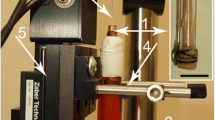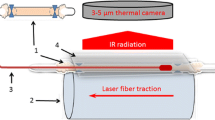Abstract
Finding optimal parameters of endovenous laser coagulation using the radiation with a wavelength of 1910 nm. In vivo experiments have been carried out on the small saphenous veins of three sheep of Edilbay breed and the dependence of venous wall and surrounding tissue damage on the radiation power was analyzed on the basis of morphological study results, as well as ultrasound examination and clinical observation of animals in the postoperative period. As radiation source, we used the diode-pumped solid-state laser, based on the LiYF4:Tm crystal, with emission wavelength of 1910 nm. For morphological study, veins were harvested immediately and 40 days after operation. Histological analysis of the vein after treatment with 1.5-W radiation revealed asymmetric wall injury and a thrombus formation in the lumen. The blood thrombus formation and pronounced vein wall damage was observed after treatment with 3-W radiation. Perivenous tissue injury is insignificant and does not lead to postoperative complications as in the case of using 1.5-W radiation. Increasing the radiation power to 4 W results in the total vein wall destruction and the thrombus formation, which persists for 40 days after the procedure. Based on the results of clinical observations of animals with registration of skin wound healing, as well as the results of histological examination of veins harvested immediately after the EVLC and 40 days after, it was concluded that the laser power value of 3–4 W can be recommended for use in the clinic.





Similar content being viewed by others

References
Weiss RA (2002) Comparison of endovenous radiofrequency versus 810 nm diode laser occlusion of large veins in an animal model. Dermatol Surg 28:56–61
Proebstle TM, Sandhofer M, Kargl A, Gül D, Rother W, Knop J, Lehr HA (2002) Thermal damage of the inner vein wall during endovenous laser treatment: key role of energy absorption by intravascular blood. Dermatol Surg 28:596–600
MILON Group http://www.milon.ru/index.phtml?tid=131
Proebstle TM, Moehler T, Gül D, Herdermann S (2005) Endovenous treatment of the great saphenous vein using a 1,320 nm Nd:YAG laser causes fewer side effects than using a 940 nm diode. Las Dermatol Surg 31:1678–1684
Almeida J, Mackay E, Javier J, Mauriello J, Raines J (2009) Saphenous laser ablation at 1470 nm targets the vein wall, not blood. Vasc Endovasc Surg 43:467–472
Pannier F, Rabe E, Maurins U (2009) First results with a new 1470-nm diode laser for endovenous ablation of incompetent saphenous veins. Phlebology 24:26–30
Sokolov AL, Liadov KV, Lutsenko MM, Lavrenko SV, Liubimova AA, Verbitskaya GO, Minaev VP (2009) Endovascular laser ablation with wavelength 1,560 nm for varicose veins. Angiol Sosud Khir 15:69–76
Vuylsteke M, Van Dorpe J, Roelens J, De Bo T, Mordon S (2009) Endovenous laser treatment: a morphological study in an animal model. Phlebology 24:166–175
Doganci S, Demirkilic U (2010) Comparison of 980 nm laser and bare-tip fibre with 1470 nm laser and radial fibre in the treatment of great saphenous vein varicosities: a prospective randomised clinical trial. Eur J Vasc Endovasc Surg 40:254–259
Pannier F, Rabe E, Rits J, Kadiss A, Maurins U (2011) Endovenous laser ablation of great saphenous veins using a 1470 nm diode laser and the radial fibre – follow-up after six months. Phlebology 26:35–39
Malskat WSJ, Giang G, De Maeseneer MGR, Nijsten TEC, Van der Bos RR (2016) Randomized clinical trial of 940- versus 1470-nm endovenous laser ablation for great saphenous vein incompetence. Br J Surg 103:192–198
Weiss RA, Weiss MA, Eimpunth S, Wheeler S, Udompunturak S, Beasley KL (2015) Comparative outcomes of different endovenous thermal ablation systems on great and small saphenous vein insufficiency: long-term results. Lasers Surg Med 47:156–160
Araujo WJB, Timi JRR, Caron FC, Cambrussi AK (2016) Development of an ex vivo model of endovenous laser ablation of the great saphenous vein in a pilot study. Acta Cir Bras 31:161–167
Chudnovskii V, Mayor A, Kiselev А, Yusupov V (2018) Foaming of blood in endovenous laser treatment. Lasers Med Sci 33:1821–1826
Srivatsa SS, Chung S, Sidhu JV (2019) The relative roles of power, linear endovenous energy density, and pullback velocity in determining short-term success after endovenous laser ablation of the truncal saphenous veins. J Vasc Surg Venous Lymphat Disord 7:90–97
Roggan A, Friebel M, Dörschel K, Hahn A, Müller G (1999) Optical properties of circulating human blood in the wavelength range 400–2,500 nm. J Biomed Opt 4:36–46
Belyaev AN, Chabushkin AN, Khrushchalina SA, Kuznetsova OA, Lyapin AA, Romanov KN, Ryabochkina PA (2016) Investigation of endovenous laser ablation of varicose veins in vitro using 1.885-μm laser radiation. Lasers Med Sci 31:503–510
Mendes-Pinto D, Bastianetto P, Cavalcanti Braga Lyra L, Kikuchi R, Kabnick L (2016) Endovenous laser ablation of the great saphenous vein comparing 1920-nm and 1470-nm diode laser. Int Angiol 35:599–604
Ashpitel HF, Dabbs EB, Nemchand JL, La Ragione RM, Salguero FJ, Whiteley MS (2018) Histological and immunofluorescent analysis of a large tributary of the great saphenous vein treated with a 1920 nm Endovenous laser: preliminary findings. EJVES Short Rep 39:7–11
Somunyudan MF, Topalogglu N, Ergenoglu MU, Gulsoy M (2011) Endovenous laser ablation with TM-fiber laser. Proc SPIE 7897:789707–789701
Sroka R, Pongratz T, Esipova A, Dikic S, Demhasaj S, Comsa F (2015) Schmedt C-G Endovenous laser therapy for occlusion of incompetent saphenous veins using 1940 nm. Proc. SPIE 9542, Medical Laser Applications and Laser-Tissue Interactions VII, 95420D (15 July 2015)
Viarengo LMA, Viarengo G, Martins AM, Mancini MW, Lopes LA (2017) Medium and long-term outcomes of endovenous treatment of varicose veins with a 1940 nm diode laser: critical analysis and technical considerations. J Vasc Bras 16:23–30
Araujo WJB, Timi JRR, Kotze LR, Vieira da Costa CR (2018) Comparison of the effects of endovenous laser ablation at 1470 nm versus 1940 nm and different energy densities. Phlebology 34(3):162–170
Park I (2019) Initial outcomes of endovenous laser ablation with 1940 nm diode laser in the treatment of incompetent saphenous veins. Vascular 27:27–32
Shaidakov EV, Ilyukhin EA, Petukhov AV (2012) Endovasal obliteration of the main subcutaneous veins – a mechanism of action. Angiol Sosud Khir 18(1):148–156
Poluektova AA, Malskat WS, Van Gemert MJ, Vuylsteke ME, Bruijninckx CM, Neumann HA, van der Geld CW (2014) Some controversies in endovenous laser ablation of varicose veins addressed by optical-thermal mathematical modeling. Lasers Med Sci 29:441–452
Popesko P (1978) Atlas of topographical anatomy of the domestic animals, vol 608, 2nd edn. W. B. Saunders Company, Philadelphia
Samuel N, Wallace T, Carradice D, Mazari FAK, Chetter C (2013) Comparison of 12-W versus 14-W endovenous laser ablation in the treatment of great saphenous varicose veins: 5-year outcomes from a randomized controlled trial. Vasc and Endovasc Surg 47:346–352
Funding
This research was supported by the Russian Foundation for Basic Research (Grant No. 18-29-20,039) and the Ministry of Education and Science of the Russian Federation (Project No. 1.4926.2017/6.7).
Author information
Authors and Affiliations
Corresponding author
Ethics declarations
Conflict of interest
All authors have completed and submitted the ICMJE Form for Disclosure of Potential Conflicts of Interest and have disclosed the following: Alexander N. Belyaev, Andrey A. Lyapin, and Polina A Ryabochkina have a patent “The method of laser obliteration of varicose veins.” Sergey A. Artemov, Alexander N. Belyaev, Svetlana A. Khruschalina, Andrey A. Lyapin, and Polina A. Ryabochkina report grants from Russian Foundation for Basic Research, during the conduct of the study. In addition, Polina A. Ryabochkina reports grant from the Ministry of Education and Science of the Russian Federation.
Additional information
Publisher’s note
Springer Nature remains neutral with regard to jurisdictional claims in published maps and institutional affiliations.
Appendix 1. Macro- and microscopic parameters of the vein wall after EVLC
Appendix 1. Macro- and microscopic parameters of the vein wall after EVLC
Morphometric operations were performed using Sigma Scan Рго 5 software (SPSS Inc., USA). The narrowing degree of the vein lumen was determined by the ratio of the total wall thickness l to the vein radius d/2 as k = 2l/d. As this ratio decreases, lumen size increase.
Macro - and microscopic parameters of the vein wall after EVLC are presented in Table 1.
The table shows change in the morphometric parameters of the vein wall after EVLC depending on laser radiation power. After treatment by a radiation with power of 4 W, a vein wall thickness decreases due to total destruction, and the k value for the residual fragment exceeds the control value. After EVLC using radiation with a power of 3 W, an increase in the k value is observed, which indicates a significant thickening of the venous wall and a narrowing of the lumen. The effect of 1.5-W laser radiation on the vessel also led to wall thickening and narrowing of the vein lumen but to a lesser extent.
Rights and permissions
About this article
Cite this article
Artemov, S.A., Belyaev, A.N., Bushukina, O.S. et al. Optimization of endovenous laser coagulation: in vivo experiments. Lasers Med Sci 35, 867–875 (2020). https://doi.org/10.1007/s10103-019-02874-6
Received:
Accepted:
Published:
Issue Date:
DOI: https://doi.org/10.1007/s10103-019-02874-6



